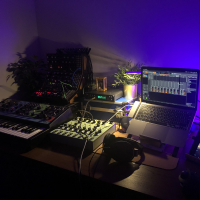Loopy Pro: Create music, your way.
What is Loopy Pro? — Loopy Pro is a powerful, flexible, and intuitive live looper, sampler, clip launcher and DAW for iPhone and iPad. At its core, it allows you to record and layer sounds in real-time to create complex musical arrangements. But it doesn’t stop there—Loopy Pro offers advanced tools to customize your workflow, build dynamic performance setups, and create a seamless connection between instruments, effects, and external gear.
Use it for live looping, sequencing, arranging, mixing, and much more. Whether you're a live performer, a producer, or just experimenting with sound, Loopy Pro helps you take control of your creative process.
Download on the App StoreLoopy Pro is your all-in-one musical toolkit. Try it for free today.
Installing your new iPad
My new iPad is on the way so within the next few days I’m busy with the process of installing quite some apps. Since I’m also keeping my old Pro 2017, everything is already installed on that device and will stay there. At this moment I have the apps in separate folders, based upon the developer name e.g. all Fabfilter apps are in the Fabfilter folder, Sugarbytes apps are kept in the Sugarbytes folder. Most of the time I pick an AU from a host like Loopy, AUM, Drambo etc. or simply by a search.
I’m also in doubt of installing everything or only the plugins that I really use. Memory isn’t (yet) an issue but perhaps it’s more clear and effective.
So I’m curious what you prefer and if you have other tricks, tips or advice.
- What do you install on your fresh 2nd iPad?14 votes
- When memory isn’t an issue, I will install every app I ever purchased.21.43%
- I’m selective and only install apps that I really use.64.29%
- Other (please specify)14.29%
- How do you organize your apps?14 votes
- I keep everything in folders, categorized by developer (e.g. Audio Damage, Bram Bos, etc.)7.14%
- I keep everything in folders, categorized by category (e.g. sequencer, MIDI, filter etc.)50.00%
- I couldn’t care less, everything is everywhere, AU’s are recognized by my host(s) anyway.28.57%
- Other (please specify)14.29%
- Where do you store your audio, MIDI, presets and libraries?14 votes
- When memory isn’t an issue I keep everything on the device itself.78.57%
- I keep the libraries (e.g. GospelMusicians) on the iPad, store the rest on an external drive.0.00%
- If possible I store all my files on and external drive.0.00%
- Other (please specify)21.43%



Comments
I did this recently when I went from my old iPad Pro to my new iPad mini 6 (and kept the old iPad Pro as an hdmi source for the ATEM) – I set the new iPad up by having it restore over iCloud from the old iPad, and didn’t let it erase the old one at the end, then got rid of a few apps I didn’t really want on the new iPad because I probably wouldn’t use them by now
For no.3 I store it all on iCloud
I use my second one for reading, streaming, and drawing. Keeps that stuff separate from my music apps.
2- These days I like a nice clean Home Screen on my iPad, so I tend to rely more and more on the App Library screen to access my apps. I also don’t have a lot installed, so it’s not a big chore.
3- I vote for both, internal and external. I have identical sample folders and back ups on the iPad and my T7, just in case. iCloud too for important projects in progress.
1 - other: don't have a 2nd iPad, so answered for what I would do if I did.
I just went for the transfer option which makes an exact copy of your old ipad's content on your new one. You can then manually delete what you don't want at your leisure. The icloud option didn't work well for me, it kept failing. But the transfer directly function worked beautifully and almost 250 gb of stuff was transferred in less than an hour. Just had to keep the 2 ipads side-by-side during that process. You'll find details online
I think that with AUv3 apps there is no point in organising them on the Home Screen, since they are not meant to be launched from there. It's much better to remove them from the Home Screen and let Apple organise them in the Library.
This is what I’ve done since the introduction of the app-library